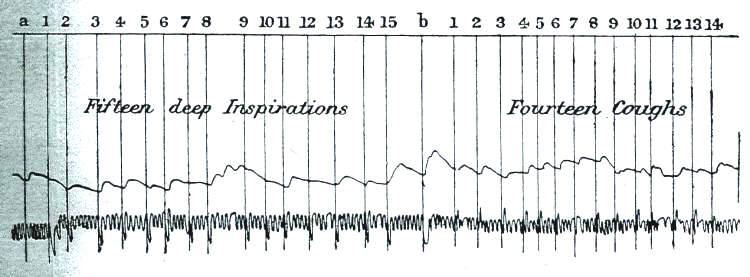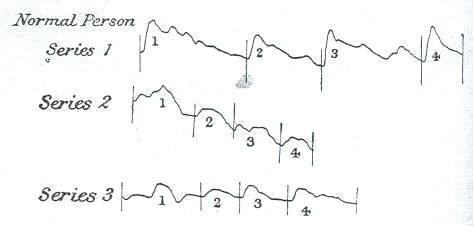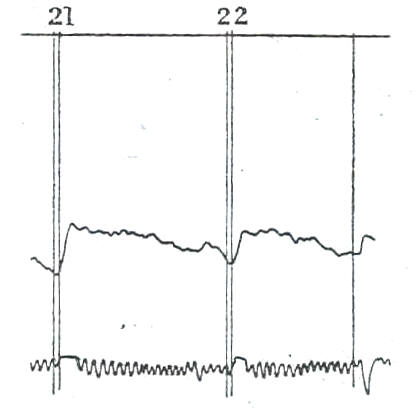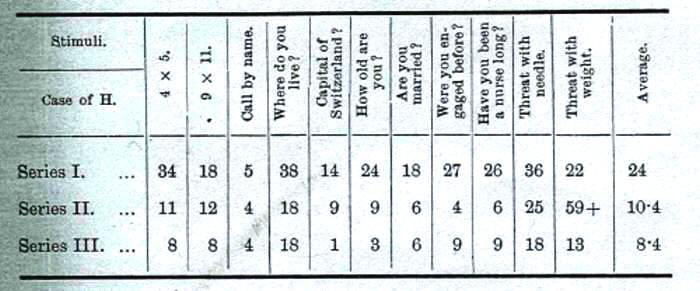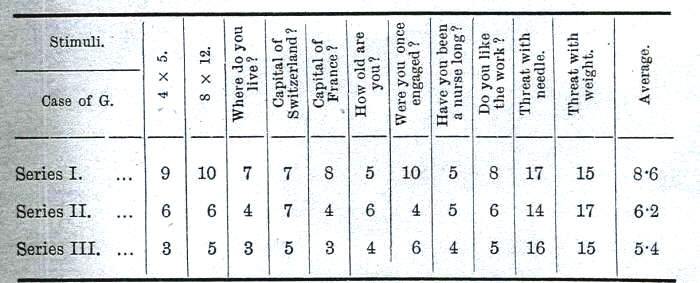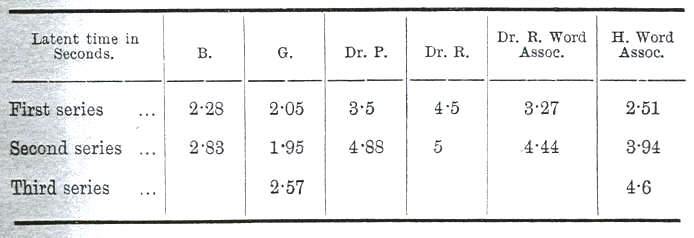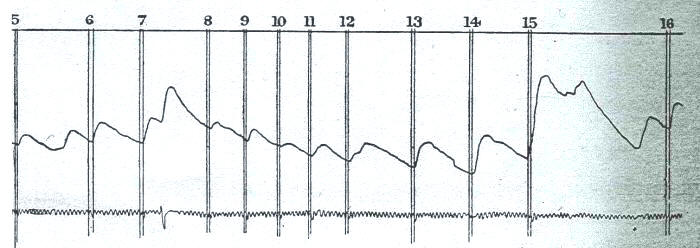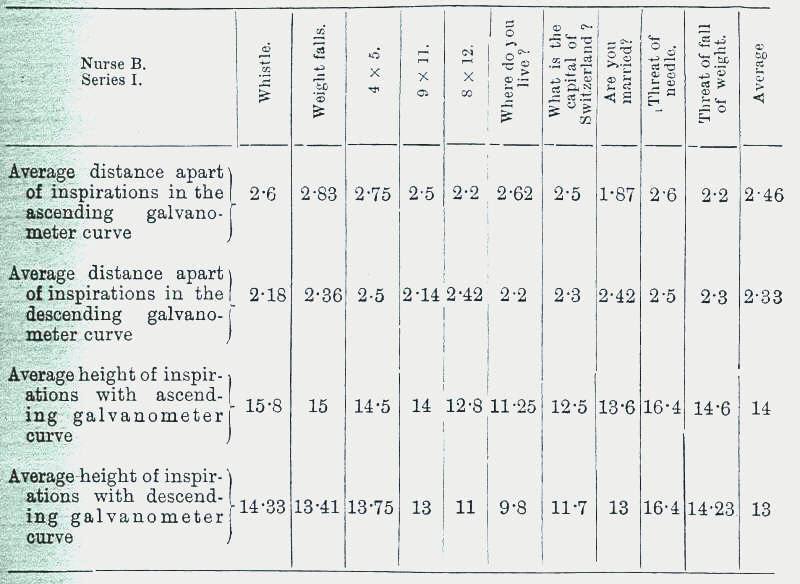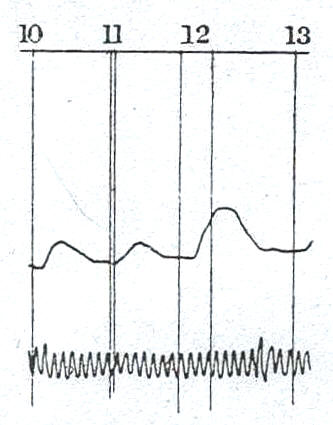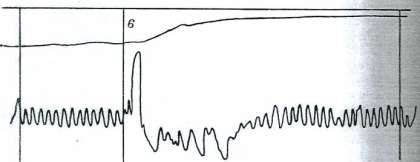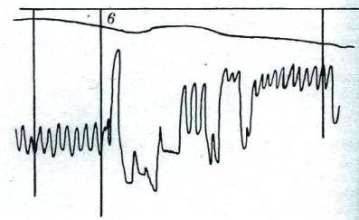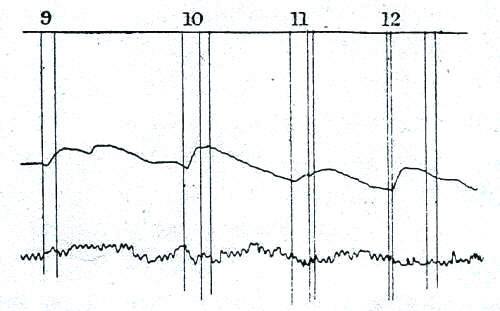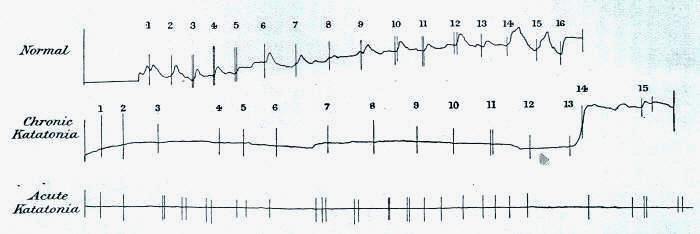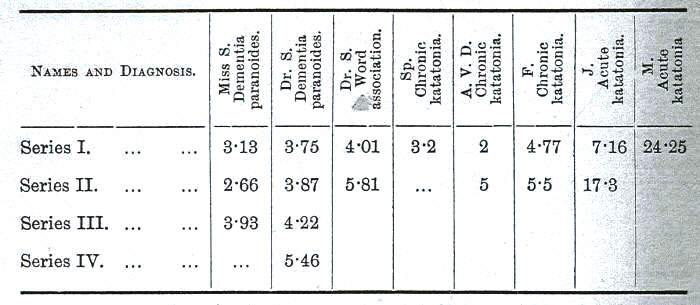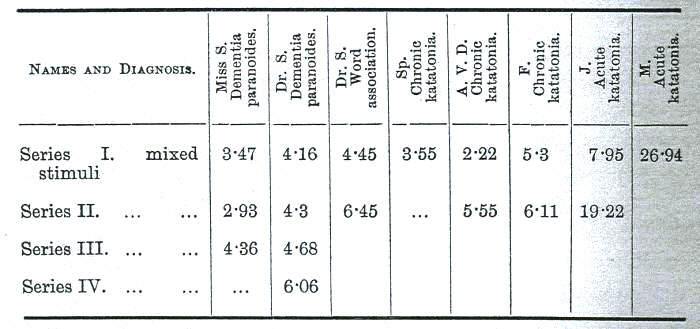|
Home Boris Menu Galvanic Research Menu Laboratory Instruments Used .pdf
These investigations were carried out in the laboratory of the Clinic for Psychiatry at Zürich, to the director of which, Professor E. Bleuler, we are under obligations for the use of apparatus and material for study. The purposes of our research were to ascertain the value of the so-called "psycho-physical galvanic reflex" as a recorder of psychical changes in connection with sensory and psychical stimuli; to determine its normal and pathological variations; to study the respiratory innervation curve in the same relations; and finally to compare the galvanometric and pneumographic curves taken simultaneously upon the kymograph, under the influence of various stimuli. In word-associations the reaction time was also registered for further comparison.
CHAPTER I―APPARATUS EMPLOYED For the respiratory curve we used the Marey pneumograph made by Zimmerman, in Leipzig. The kymograph was made by Schüle, in Basel, and runs with a weight, making it both steady and noiseless. The stop-watch employed for reaction time was manufactured by Billian, of Zürich. The use of the galvanometer in experimental psychology is so new and recent as to require a special description and a brief review of the scanty literature of the subject. The first to discover the influence of mental conditions on the galvanometer was Professor Tarchanoff, who published a paper in Pflüger’s Arch. für Physiologie, 1890, entitled "Galvanic Phenomena in the Human Skin in Connection with Irritation of the Sensory Organs and with various Forms of Psychic Activity." He employed tubular unpolarisable clay electrodes, connected with the skin by means of hygroscopic cotton pads, 10 to 15 cm. long, saturated with saline solution. These are attached to a Meissner and Meyerstein galvanometer. Deviations of the mirror were noted through a telescope upon a scale three metres distant from the galvanometer. The scale was divided on each side of the zero point into 50 cm. and these again into mm. The galvanometer was so sensitive that a nerve stream of a frog's sciatic nerve deflected the mirror so much that all the divisions on the scale were passed over. The electrodes were applied at various times to different portions of the body, such as the hands and fingers, feet and toes, the face, the nose, the ears and the back. Experimenting thus, he obtained the following results:― Light tickling of the face, ears, or soles of the feet, with a camel-hair brush or a feather, induced, after a latent period, of from one to three seconds, a deflection in the galvanometer to the extent of the whole 50 cm. of the scale. The same results were obtained by stimulating the skin with the faradic brush, with hot and cold water, and by pricking with a needle. Irritation in analogous ways of other sensory organs, the ear, the nose, the tongue and the eye, affected the galvanometer in a corresponding manner. The experimenter then ascertained that actual irritation was not essential to these results, but the presentation of the proposed stimulus to the imagination also brought about similar deviations in the galvanometer. He stated, furthermore, that the recollection of some fear, fright or joy, in general any kind of strong emotion, produced the same result. The next point of interest recorded by Tarchanoff was that ordinary abstract mental exercise, such as computation, does not affect the galvanometer unless the exercise be accompanied by exertion. He also noted that the emotion of expectant attention or anticipation had a marked effect upon the galvanometer. Tarchanoff regarded the phenomena he observed as due to a secretory current of electricity associated with the sweat-glands. He was evidently unaware of the extraordinary value of the investigations he described in this brief paper. Like many discoveries of importance, his remarkable work lay buried in medical literature for years, and it was not until 1897 that any further contribution on his subject appeared. In that year, Sticker [13] records a repetition of the work of Tarchanoff. His conclusion was that the capillary system of blood-vessels was a factor in the perturbations of the galvanic current. He opposed the idea of Tarchanoff of the centripetal excitation of a secretory current, because he found that the same deviations were noted when the electrodes were applied to anæsthetic and analgesic areas of skin (functional or organic). After the lapse of five years, Sommer [12] made some experiments with the galvanometer, but lost himself in technical and physical details, and failed completely to grasp the intrinsically valuable features of the instrument. He observed fluctuations which he attributed to alterations in resistance of the skin or to changes in contact between skin and electrodes. He thought any apparent psychic influence due to involuntary muscular contractions induced by increased pressure on the electrodes, and concluded that except for the reaction to tickling, no psychic influence on the galvanometer could be established with certainty. He therefore stumbled over, but missed, the one essential point. About two years ago E. K. Müller, an electrical engineer, of Zürich, read a paper before the Swiss Society of Natural Sciences (medical section) on "The Influence of Psychic and Physiological Phenomena upon the Electrical Conductivity of the Human Body." Happening to make certain experiments upon himself in relation to the resistance of the human body in the alternating magnetic field, he rediscovered the deflectibility of the mirror-galvanometer under psychic and nervous stimulation as established by Tarcharoff. Dr. O. Veraguth, a neurologist, of Zürich, was then led by Müller to experiment in the same direction. He made use of the Deprez-D'Arsonval mirror-galvanometer, nickel-plated brass cylinders for electrodes, a feeble electric current, a horizontal celluloid scale on which the light from the mirror registered its movements and an apparatus for photographic delineation of the fluctuations. He published some results last August (1906) in the Arch. de Psychologie (Geneva), and he gave the name “psycho-physical galvanic reflex" to the phenomenon.1 Veraguth corroborates the findings of Tarchanoff. One or two of his experiments are especially striking. If the individual under observation is read to, deviation of the mirror is noted when passages associated with emotional tone are reached. Or, if a series of unrelated words is pronounced, a test suggested to him by one of the authors of this paper (Dr. Jung), words connected with some emotional complex produce an effect on the galvanometer, while indifferent words have no effect. He concludes from his studies that only such irritations as are associated with sufficiently intense and actual emotional tone induce a deviation in the galvanometer. He states in his paper that he is not yet in a position to explain the phenomenon, but that if change in resistance were the cause then there are presented manifold contradictions to our present conceptions of resistance in the human body. He did not think it due to alterations in the quantity of blood in the parts beneath the electrodes, for the phenomenon takes place whether the hands be emptied of blood by an Esmarch bandage or supercharged with blood by artificial venous stasis. Veraguth excludes the participation of the perspiration, for the results were similar in hands made dry in formalin. As far as we know the above review covers the brief literature of the subject, but work has been carried on for about a year in this field, in the laboratory of the Psychiatric Clinic at Zürich, the most of which has not yet been published. One of us (Dr. Jung) has published in the Journal of Abnormal Psychology (Boston), for February, 1907, the association experiments in which the galvanometer was employed, and in this article is a drawing of the apparatus and a description of the order of research. In the same laboratory, Dr. L. Binswanger, together with Dr. Jung, has investigated the physical and physiological problems presented by the phenomenon, the results of which will shortly be published in a separate paper, though the material conclusions of their investigations are embodied in this paper. The apparatus employed by us is as follows: The mirror galvanometer of Deprez-D'Arsonval; a translucent celluloid scale divided into millimetres and centimetres with a lamp upon it (made by Zulauf & Co. of Zürich), the scale being of' one metre from the galvanometer; a moveable indicator sliding on the scale and connected by a device of DR. Jung with a recording pen writing upon the kymograph; a rheostat to reduce the current when necessary; and one, sometimes two, Bunsen cells. The electrodes generally used are large copper plates, upon which the palms of the hands rest comfortably, or upon which the soles of the feet may be placed. We have also used jars of hot water for the contact, when, as with some instances of dementia præcox, the hands were congested and cold. 0ccasionally we have employed a plate of zinc for one electrode and a plate of carbon for the other (in which case no element was required, since the skin, sweat and metal provided sufficient current).
CHAPTER II―THE PHYSICS AND PHYSIOLOGY
OF THE So far as has yet been determined, it would seem that the sweat glandular system is the chief factor in the production of this electric phenomenon, inducing on the one hand under the influence of nervous irritation a measurable current or, on the other hand, altering the conductivity of the current. Since water contact excludes changes induced by pressure on metal electrodes, and blanching of the fingers by the Esmarch bandage excludes changes in connection with the blood supply, both of these factors play but a small part in the deviations of the galvanometer. Change in resistance is brought about either by saturation of the epidermis with sweat, or by simple filling of the sweat-gland canals or perhaps also by intracellular stimulation; or all of these factors may be associated. The path for the centrifugal stimulation in the sweat-gland system would seem to lie in the sympathetic nervous system. These conclusions are based upon facts at present to hand and are by no means felt to be conclusive. On the contrary, there are features presented which are as yet quite inexplicable, 2 as for instance, the gradual diminution of the current in long experiments to almost complete extinction, when our ordinary experience teaches that resistance should be much reduced and the passing current larger and stronger. This may possibly be due to gradual cooling of the skin in contact with the cold copper plates. This can be obviated by warm water contact or by resting the copper plates upon warm sand bags. Yet there is still an inviting field for investigation here.
§1―Fluctuations of the Galvanometer from
Physical Causes
§2.―Fluctuations of the Galvanometer from Psychic Causes in Normal Individuals Expectation.―As soon as the galvanometric experiment begins, and the circuit through the test person is closed, there is a rather rapid rise with some fluctuation of a curve induced by expectant attention. Tarchanoff was much struck by this. Attention is, as Bleuler [1] has pointed out, nothing more than a special form of affectivity. Attention, interest, expectation, are all emotional expressions. The extent of this expectation curve rises in normal individuals, depending upon their varying degree of affectivity. Expectation is not only manifested at the beginning of an experiment in the galvanometer curve, but may be observed throughout the experiment in connection with every stimulus, sensory or verbal. It is particularly strong in connection with the threat of pricking with the needle, or threat of letting fall a heavy weight. The influence of expectation on the curve becomes less with each repetition of the same series of stimuli, and seems to disappear wholly with indifferent stimuli; while, with the threat stimuli just referred to, which are more lively and actual, repetition may diminish the curve, or at times increase it if the test case is uncertain whether the threats in the repetition are to be a real prick of the needle or an actual fall of the weight. In beginning an experiment, we therefore wait until the first influence of the emotion of expectation has subsided. Emotion.―Excluding the affect of attention, we find that every stimulus accompanied by an emotion causes a rise in the electric curve, and directly in proportion to the liveliness and actuality of the emotion aroused. The galvanometer is therefore a measurer of the amount of emotion and becomes a new instrument of precision in psychological research. Imagined emotion.―The amount of deflection seems to stand in direct relation to the actuality of the emotion; but, as Tarchanoff pointed out, the presentation of an emotion already outlived to the imagination does deviate the galvanometer, such deviation depending naturally upon the facility of the test person in living over the old emotion in his imagination. The following experiment, tried upon one of the writers, is an illustration: The list of stimuli was placed before him, while the reader of the deviations called off at intervals Nos. 1-2-3-4-5-6, allowing time for concentration upon the idea, and for the rise and subsidence of the wave. Between the periods of concentration on the emotional images, the test person allowed his eyes to wander indifferently about the room, and his mind to run on in different objects seen. An Experiment in the Deflection of the Galvanometer in Imagined Conditions.
Series of stimuli used.―A series of stimuli, sensory and verbal, strong and indifferent, intellectual and emotional, was arranged and tested upon numerous normal individuals, besides which word associations were used in connection with the galvanometer. In some of the experiments the test person was in an adjoining room, the electric connections and signals being easily adjusted for this purpose. The following is the series of stimuli:―
(5) Multiply 8 by12. (6) Sudden call of a person tested by name. (7) Where do you live? (8) What is the capital of Switzerland? (9) What is the capital of France? (10) How old are you? (11) Are you married? (12) Were you engaged once before?' (13) Have you been long at your present employment? (14) Threat of prick with needle after counting 1―2―3. (15) Threat of allowing heavy weight to fall after counting 1―2―3. (16) What is your first name? (17) What is the first name of your wife? (18) Is she pretty? (19) We have now finished. The verbal stimuli were varied to a slight degree with various individuals, to adapt them to different conditions and circumstances, but the general character of the stimuli was the same. Here, too, the relations are somewhat obscure, which may be owing to the occurrence of very few altered reproductions. Only half of the above numbers coincide with our expectations. These stimuli were ordinarily repeated three times in each individual, normal or pathological, and subsequently the series of word stimuli were given for the word associations, these were also repeated once or twice. From seventy curves, fig. 2 (H., nurse, Series III) is selected as a general illustration of the galvanometric curve.
This man was emotional and in the third series here presented the curves and more rounded than in the first and second series. At the same time they serve to show the character of the emotional curve. Stimuli 3, 4, and 5, although they were but simple multiplication, induced an emotional curve because H. was a nurse and was embarrassed in doing mental arithmetic before experimenters. Stimuli 8, 9, and 10 were practically exhausted in this third trial and show very little. Between 10 and 11 someone entered the room. The weight was let fall twice between 13 and 14 instead of at 2, and being unexpected produced a large and a smaller wave of alarm. The threatened needle at 14 and threat of fall of large leaden weight at 15 still produced large waves, and show how strongly actuality in an apprehension influences the curves. Again, at 18 the enquiry if his wife was pretty, she being far from so, induced a lively emotion and correspondingly high wave, for this question was here a surprise as well, not having been asked in the preceding series.
Exhaustion of stimulus by repetition.―When the first series of stimuli is recorded, the curves are usually characterised by abrupt ascent and descent with rather sharp summits. The curves diminish in size and the summits
become more rounded by each repetition, showing a slower excitation and slower reaction of the emotion. This is well illustrated in fig. 3, where several curves induced by the same stimuli in the first, second, and third series in the same individual are reproduced. Wave No. 1 in Series I also exhibits in the descent the fluctuating character of an emotion which is slowly and waveringly passed off. This is even better shown in fig. 4, from Case G., who was asked questions calculated to produce a complex emotional state such as the galvanometer perfectly indicates. In quite a number of instances the heights of the waves of the three successive series were measured and the following two illustrations are selected as examples of the differences in height (in millimetres) of the curves of the stimuli in the three series. Waves were selected which had not been affected in any of the series by interruptions, change of contact, coughing or deep inspirations. Table 1, Case of H. Diminishing Excursions of Galvanometer in Successive Stimulations.
Table 2, Case of G. Diminishing Excursions of Galvanometer in Successive Stimulations.
Note.―In the averages of these two tables the eleventh column of figures was not included as the emotion of expectation that the weight would really be dropped modifies especially the second trial, while in the third trial there was less of such expectation. In these tables the falling off of the height of the emotional curve was very well shown, and in both the livelier affects produced even in repetition by actual threats of the needle and weight are typical. In Series II of the first table the threat with the weight raised the curve to over fifty-nine because the trial person thought that the weight would actually fall in this experiment, whereas before it was a threat only. Latent time.―It was noted by Tarchanoff that the galvanic wave began to rise from one to three seconds after a stimulus was given. We have verified this period time in all normal conditions, but the latent time varies with different people and at different times. In the curves that we have thus far taken we could not well complicate the apparatus with a chronograph adjustment, and have estimated the space of latent time in a number of normal cases by measuring the distance of the curve from the moment of stimulation to the beginning of ascent of the emotional curve, taking the measurements in millimeters. The kymograph drum revolved slowly. The following results were obtained. Nurse B. with the series of mixed stimuli given above showed in the first series an average of 2.06 millimetres; the repetition of the second series averaged 2.55 millimetres; with Nurse G. and the same series of mixed stimuli in Series I the average was 1.85, in the second 1.76, and in the third or final series 2.32 millimetres. Dr. P with the same series showed an average latent period in the first trial of 3.15, and in the repetition an average of 4.40. Dr. R. with the same series had an average period in the first trial of 4.05 millimetres, and in the second trial of 4.50 millimetres. In a series of word associations Dr. R. showed at first an average period of 2.95 millimetrers, and in the repetition immediately after the average was 4 millimetres. With word associations Nurse H. showed in the first series an average latent period of 2.26; in the repetition or second series the latent period was increased to 3.55, and with a third trial of the same words the latent period had become 4.14. These figures with regard to the latent period show therefore that with repetition there is an increase of the latent period of time simultaneously with the rounding off and diminishing amplitude of the curve, both corresponding with exhaustion of the power of the stimulus. We were unable to determine in this investigation that there was any marked difference in latent time in relation to the various forms of stimulation whether physical or psychic, and when psychic with or without answer to questions or words, though such differences will probably be discovered by further experiment directed to this end. Normal individual variations of galvanometer curve.―We find considerable difference in the curves made by the galvanometer in normal persons. In some the waves are of rather small and even excursion, corresponding to the unemotional or phlegmatic nature of the test person. In others there is wide excursion, with fluctuating or bifurcated waves, rapid ascents and descents, expressing great emotional lability. These normal variations are illustrated in figs. 5 and 6.
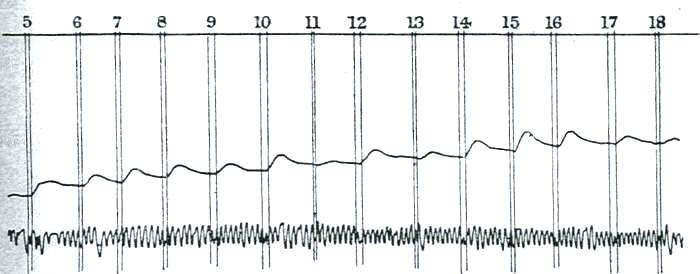 Fig. 5. Dr. R., normal curve with rather indifferent word association stimuli. Unemotional type. With a stop watch we estimated that the time of revolution of the drum was 4.55 millimetres in five seconds. Hence the latent time in the above normal individuals was about as follows :
CHAPTER III.―THE PNEUMOGRAPH AS AN INDICATOR OF PSYCHIC PROCESSES. The relation of the respiratory innervation curve to psychic processes in both normal and pathological conditions has not yet been thoroughly investigated. Mosso (1879-1893) was one of the earlier investigators in the physiological application of the pneumograph and could reach no satisfactory conclusions from a study of the respiratory curve under sensory stimulation. Delabarre [2] states that respiration increases in frequency and depth with attention. to sensory stimulation, and with
FIG. 6. H., an attendant, normal curves, very labile emotions. The numbers here correspond to the series of mixed stimuli, 15 is threat of weight. mental processes increases in frequency and diminishes in depth. Lehmann [7] states that every pleasant impression increases the depth of breathing, and that strong unpleasant impressions are accompanied by several deep respiratory movements. Mentz [9] employed pleasant and unpleasant acoustic stimuli in a study of the pulse and breathing, and as regards respiration observed with strong stimulation first slowing and then shortening of the respiratory movements. He noted also a marked influence of attention on the results. Involuntary attention generally induced prolongation of breathing, while voluntary attention caused abbreviation of the movements. Pursuing his studies farther he investigated the action of pleasant and unpleasant stimuli and of the effects upon pulse and respiration. As regards the former, pleasant feelings lengthened the pulse curve and unpleasant ones shortened it, and he regards the respiratory curve as running a parallel course. With affects there was prolongation of the respiratory movements, and with increasing strength of the affects an increasing height or depth of the breathing curve. Zoneff and Meumann [17] finding nothing sufficiently definite in literature in relation to the correspondence between respiration and circulation and psychic or emotional processes, have made an exhaustive research upon normal individuals, employing various stimuli, optic, acoustic, gustatory, cutaneous and psychic (arithmetical problems and space conceptions) and studied at the same time the effects of voluntary attention and pleasant and unpleasant impressions upon the breathing and pulse. They found that as a rule attention produced acceleration of the breathing, especially at the end of the stimulation, and in addition to acceleration the breathing might become more shallow or be inhibited. This inhibition may appear as shallow and more rapid breathing, or there may be a partial or complete standstill of the respiration, and is greater in direct proportion to the degree of attention. Complete inhibition was found more often in attention to sensory than to intellectual stimulation. There were variations in the results in different individualities. There were fluctuations in the curves which they considered as being due to fluctuations in attention. In relation to pleasant and unpleasant stimuli they concluded that all pleasant sensations cause shallowing and acceleration of the breathing, and all unpleasant sensations deepening and slowing of respiration, or, in other words, that the former diminish and the latter increase respiratory function. In experiments with diversion of the attention together with stimulation, they found that emotional effects upon breathing and pulse ceased. In experiments with concentration of attention on stimulus and sensation, attention strengthened the effects of both pleasant and unpleasant feelings upon the curves. While their work is the best that has yet appeared upon this subject, it must still be confessed that experiments of' this nature carried out upon the trained assistants or students connected with the laboratory are more or less artificial, and this, together with the extremely simple character of the stimulation, would make their criteria for complex emotional phenomena with which we have to deal only relatively valuable. Martius and Minnemann [8] in a thoroughly iconoclastic and yet excellent work point out many fallacies in the studies of Lehmann, Menz and Zoneff and artefacts of a mechanical nature, and wrong conclusions as to the relations between affects, and pulse and curves. They themselves find the normal respiratory curve inconstant, subject to variations due to age, temperament, perseveration of affect, reactions from the affect, embarrassment from the experiment, undue interest in procedures, &c., and their chief conclusion is that the main changes in breathing in emotional conditions consist of quickened or lengthened tempo, with diminished in either case. Believing that a study of the inspiratory curve would throw the most light upon the relation of respiratory innervation to psychic processes, we set before ourselves problems for consideration, viz., the character of the usual respiratory curve, the character of the curve in stimulation without verbal reaction, the influence of verbal reaction with indifferent stimuli upon the curve, whether distinct emotional complexes affected uniformly the pneumographic curve, whether there were marked disturbances of the respiratory without corresponding changes in the galvanometric curve, and, finally, what influence attention has on both galvanometer and pneumograph. We have not been able as yet to reach satisfactory conclusions on all of these points, for the material already available is more than we have yet had opportunity thoroughly to investigate; but so far as the results obtained are of interest. The figures in the table given below show a regular, though not constant, relation between the galvanometric and the pneumographic curves in one case.
Measurements to Show
the Relation in Frequency and Amplitude of Inspirations to Ascending and
Descending Portions of the Galvanometer Wave To obtain these relations it is necessary to select an experiment in which the galvanometric curve has not been influenced greatly by the several sources of error, and the simultaneous pneumographic curve has not been modified too much by verbal reaction, coughing, &c. Taking the typical curves of several such series, measurements were made to determine the relative number of inspirations synchronous with the ascending galvanometer curve, and also with the descending galvanometer curve. The amplitude of each inspiration was also measured and averaged for the same purpose, and the measurements are recorded in millimetres. It will be seen that the ascending portion of the galvanometer curve, which is the result of an emotional stimulus, is accompanied by fewer inspirations as well as by deeper ones. While this seemed to be a general rule in this instance, we find variations in different individuals with the same mixed series of stimuli, and in some cases the reverse. The stimuli in the table were unpleasant rather than pleasant to the test person. But the determination of the emotional tone in any such experiment is very difficult. The forced and artificial situation of the test person in itself induces pleasant feelings, and any pleasant stimulus must therefore simply bring about a certain relief or relaxation in a situation of unpleasant tension. The nervous tension during an experiment must naturally influence the breathing, and a pleasant stimulus is apt to produce only a temporary lessening of such tension. This is a criticism we would make of the Zoneff and Meumann experiments, and of experiments with the pneumograph in general. It is altogether probable that there are more inexplicable influences at work in relation to the pneumographic curve than we are at present able to comprehend. There are many respiratory fluctuations which have nothing to do with the emotions, but are the result of physical or intellectual processes, with the enforced quiet of body of the test person, with the disposition to speak, with tendencies to cough or to swallow, &c. Furthermore, there will be a difference in the curve if the stimulus occurs during an inspiration or an expiration, and there are individual variations dependent upon temperament, upon lability of the emotions. We have, therefore, not been greatly impressed with the value of a possible relation between the galvanometric and pneumographic curves since it is not constant, and the more we have studied comparatively the two synchronous curves, the more have we been impressed with a surprising divergence between the influences at work upon them. We have studied hundreds of waves in every conceivable manner. For instance, we have taken series of galvanometric curves and carefully measured the length of each inspiration, and the intervals between inspirations, as related to the point of stimulus, to the latent space before the ascent of the galvanometer wave, to the ascending curve, to the crest, to the descending curve, and to the space to the next point of stimulus, without developing any regular and constant relationship or correspondence, though we think this may ultimately be shown to exist in some degree. On the contrary, we have found thus far that the influences at work upon the two curves reveal an astonishing regularity of difference. When the emotions are very labile, and show the most marked excursions in the galvanometer curve, the respiratory curve is often regular and even (fig. 7).
On the other hand, in instances both normal and pathological, where the galvanometer curve is marked by little fluctuation, or even by none, as in some cases of katatonia, there will often be most decided variations in the pneumographic curve. We often note a change in character in pneumographic curves, not so much with each separate stimulus, but during the whole course of a series of stimuli as if expectant attention and nervous tension diminished the inspirations during the early part of the series, and as if there were a relaxation during the latter half with longer inspirations (fig. 8).
There does not seem to be the intimate and deep relationship between the respiratory function and the unconscious emotions that exists between the sweat glandular system and these emotions. It is a matter of everyday experience that the respiration is influenced by our conscious emotions, especially when they are strong, as instanced in such expressions as “baited breath," "breathless with astonishment," &c. Such inhibitions of breathing are noticeable in many pneumographic curves, particularly in association with expectation and tension. But do, perhaps, the emotions of the subconscious, roused up by questions or words that strike into buried complexes of the soul, reveal themselves in the galvanometer curve, while the pneumographic curve is comparatively unaffected? Respiration is an instrument of consciousness. You can control it voluntarily while you cannot control the galvanometer curve. The respiratory innervation is closely associated with speech innervation, anatomically and functionally, and the physical connection in the brain is, perhaps, one of the closest and earliest. Let us take these remarkable curves of a case of acute katatonia (figs. 9A and 9B), which may be regarded as a psychological experiment in diverting both attention and ordinary emotion.
A.
B. FIG. 9. J., acute katatonic stupor (Case No.10). A is a wave selected from the series in which 6 is sudden call by name. The galvanometer curve is slight, but the change in the pneumographic curve is notable. B is the same stimulus in the repetition of the series.4 Attention and all other emotions being practically diverted the pathological process, the galvanometer curve is slight (indeed, in the second repetition it was a straight line), but the sudden call of the patient by name produced the extraordinary fluctuations in the respiratory curve, though nothing was apparent in his outward demeanor to show that he was conscious in any degree of the stimulus. He may have been conscious of the call, but we had no means of determining this. In the repetition the same fluctuations occurred, proving that they were not fortuitous. The only reasonable explanation of this phenomenon, in our opinion, is that the call of the name developed a disposition to speak, stimulated the hearing centre, and the closely-associated speech centre, the motor innervation from which acted upon the respiratory muscles. Ordinarily a sudden call by name, which is one of strongest and deepest of stimuli, produces an answer. In this instance the call by name was a stimulus that acted as in a simple reflex process, and led to motor manifestations in the respiratory muscles connected with the motors speech centre, analogous to the contraction of the eyelids in response to a sudden flash of light. Fig. 10 is another instance of almost like character.
While inconstancy of emotional variations in the respiratory curve and in correspondence with the galvanometer curve has been the rule in our findings thus far, we have learned that inhibitions, when they occur as an expression of expectant attention or of other emotions, are almost always shown in the expiratory curve and not in the inspiratory, which would accord with our idea that intellectual, emotional or conscious innervation is associated with inspiration, whereas expiration is rather a physical process or relaxation, prone to be inhibited, but not otherwise affected by the active respiratory nerves. In reiterating our opinion that the galvanometer curve is probably more intimately connected than the pneumographic curve with the subconscious emotional complexes, we would add that there is a greater tendency also to persistence the pneumographic curve when emotion is expressed in it, for the galvanometer curve subsides rather quickly with the fall of the emotion, while the pneumographic curve may show traces of conscious reminiscence of the emotional stimulus for a much longer time. The galvanometer is rather an index or measurer of acute feeling tone. Thus far, for the purposes of this study of the curves under normal conditions, we had made some forty series of curves in eight normal individuals, educated and uneducated. After this we made some thirty series of curves in eleven cases of dementia præcox of different types, viz.: Dementia paranoides three, hebephrenia two, and katatonia six cases (three chronic and three acute), and to these tests we will now turn our attention.
CHAPTER IV.―THE GALVANOMETRIC AND PNEUMOGRAPHIC CURVES IN DEMENTIA PRÆCOX. Before recording the results of our experiments in dementia præcox it is necessary to say something of the psychology of the disorder. The chief characteristic in the mental condition of these patients is a peculiar disturbance of the emotions. In chronic conditions we have, as Kraepelin has clearly shown, an "emotional atrophy." In acute conditions there is a species of "incoordination" or “ataxia" between affectivity and concepts, as well demonstrated by Stransky [14]. The emotional disturbance has also been called "inadequate emotional tone." But these phrases represent rather the superficial impression that these patients make upon the physician. As soon as one examines the phenomena analytically and critically, the difficulty of attaining to a common point of view as regards all the morbid emotional symptoms is found to be extraordinary. We see at once that in most cases of dementia præcox all of the emotions are not changed or destroyed. We find, indeed, on closer analysis that many normal feelings are present. Cases with complete loss of all emotion are exceptional. Elementary affects, such as fright, anxiousness, pleasure, embarrassment, shame, &c., are usually preserved. There is even at times an increased affectivity, or real nervous sensitiveness, present. Furthermore, in cases where one would expect more or less diminution of affectivity from their previous conduct and life the elementary feelings are still maintained. The disorder is then shown in what Janet calls the “fonction du rèel”5 or the psychological adaptation to environment. It is hardly to be expected that we should find characteristic disturbances in such patients by our experimental method (psycho-galvanic), since they would lie in quantitative differences between the various feeling tones. Even were qualitative changes there they would be too small for recognition. One of the chief factors in psychological adaptation to environment is attention, which renders possible all the associations necessary to normal existence. In dementia præcox, especially the katatonic form, there are marked disorders of attention, which are shown by lack of power of voluntary concentration; or, otherwise expressed, objects do not excite in the diseased brain the affective reaction which alone permits of an adequate selection of intellectual associations. This defective reaction to stimuli in the environment is the chief feature of dementia præcox. But this disorder is not simple and elementary; on the contrary, it is very complicated. What is its origin? There is in the psychology of dementia præcox still another characteristic which throws light upon the problem. By means of word associations and subsequent analysis we find in these cases among other abnormal manifestations certain thought complexes associated with strong emotional tone, one or several of which are fundamental complexes for the individual and embody as a rule the emotions or experiences which immediately preceded the development of the mental disorder. In suitable cases it is possible without much trouble to discover that the symptoms (delusions, hallucinations, insane ideas) stand in close relation to these psychological antecedents. They, in fact, as Freud has shown, determine the symptoms. Freud applied his method particularly to hysteria, in which he found conscious or unconscious constellations with strong affective tone which may dominate the individual for years, or even the whole life through, by their might exerted upon associations. Such a morbid complex plays the part of an independent being, or soul within a soul, comparable to the ambitious vassal who by intrigue finally grew mightier than the king. This complex acts in a particular way upon the psyche. Janet [5] has described it in an excellent manner in his book. The complex robs the ego of light and nourishment, just as a cancer robs the body of its vitality. The sequelæ of the complex are briefly as follows: Diminution of the entire psychic energy, weakening of the will, loss of objective interest and of power of concentration and of self-control, and the rise of morbid hysterical symptoms. These results can manifest themselves also in associations, so that in the hysterical we find clear manifestations of emotional constellations among their associations. But this is not the only analogy between dementia præcox and hysteria. There are numerous others which we cannot here describe in detail. One may, however, call attention to the large number of undoubted katatonic processes which were formerly called "degenerative hysterical psychoses." There are many cases, too, of dementia præcox which for years are not to be distinguished from hysteria. We call attention to the similarity of the two disorders here in order to show that our hypothesis of the relation between “psychological adaptation to environment," and an emotional complex is an established fact in the matter of hysteria. If we find in dementia præcox similar conditions, we are justified in assuming that here, too, the general disturbances of mind may have a close causal relationship with an underlying complex. The complex is naturally not the only cause of dementia præcox, as little as it is of hysteria. Disposition is also a chief agency, and it is possible that in the disposition to dementia præcox affectivity brings about certain irreparable organic disturbances, as for instance metabolic toxins. The difference between dementia præcox and hysteria lies in certain irreparable sequelæ and the more marked psychic disturbances from the former disorder. Profound general disturbances (delirium, severe emotional crises, &c.), exceptional in hysteria, are usual in dementia præcox. Hysteria is a caricature of the normal, and therefore shows distinct reactions to the stimuli of the environment. In dementia præcox, on the other hand, there is always defective reactions to external stimuli. There are characteristic differences in relation to the complex. In hysteria with very little trouble the complex may be revealed by analysis, and with a good prospect of therapeutic advantage in the procedure. But in dementia præcox there is an incapability of being thus influenced. Even if, as is sometimes possible, the complex may be forced to reproduction, there is as a rule no therapeutic result. In dementia præcox the complex is more independent and more strongly detached, and the patient more profoundly injured by the complex than is the case in hysteria. For this reason the skilled physician is able to affect by suggestion acute hysterical states which are nothing but irradiations from an excited complex, while fails in dementia præcox where the inner psychic excitement is so much stronger than the stimuli of the environment. This is also the reason why patients in the early stages of dementia possess neither power of critical correction nor insight, which never fail in hysteria even in the severest forms (Raimann [11]. Convalescence in hysteria is characterised by gradual weakening of the complex till it vanishes entirely. The same is true in the remissions of dementia præcox, though here there is always some vestige of irreparable injury, which, even if unimportant, may still be revealed by study of the associations. It is often astonishing bow even the severest symptoms of dementia præcox may suddenly vanish. This is readily understood from our assumption that the acute conditions of both hysteria and dementia præcox are the results of irradiations from the complex, which for the time conceal the normal functions that are still present. For example, some strong emotion may throw a hysterical person into a condition of apathy or delirium, which may disappear the next moment through the action of some psychological stimulus. In like manner stuporous conditions may come and go quite suddenly in dementia præcox. While such patients are under the spell of' the excited complex, they are for the time completely cut off from the outside world, and neither perceive external stimuli nor react to them. When the excitement of the complex has subsided, the power of reaction to the environment gradually returns, first for elementary and later for more complicated psychological stimulation. Since, according to our hypothesis, dementia præcox can be localised in some dominating psychological complex, it is to be expected that all elementary emotional reactions will be fully preserved, so long as the patient is not in complete control of the complex. We may, therefore, expect to find patients with dementia præcox, who show psychological adaptation in elementary matters (eating, drinking, sleeping, dressing, speaking, mechanical occupation, &c.) the presence of some adequate emotional tone. But in all cases, where such psychological adaptation fails, external stimuli will produce no reaction in the disordered brain, and even elementary emotional phenomena will fail of manifestation, because the entire psychic activity is bound up with the morbid complex. That this is an actual fact is shown in the results of our experiments. The following is a brief résumé in each case of the features that have interest for us here:― (1) H., male, aged 43, teacher of languages. Insane first ten years ago. Well educated and intelligent. Entered an asylum for a time in1896. Passed through a light period of katatonia, with refusal of food, bizarre demeanor and auditory hallucinations. Later always persecutory ideas. In August, 1906, he murdered one of his supposed persecutors, and since then has been in this asylum. Very precise and correct in his dress and conduct, industrious, independent, but extremely suspicious. Hallucinations not discoverable. Diagnosis― Dementia paranoides. (2) Miss S., aged 61, dressmaker. Became insane about 1885. Innumerable bizarre delusions, delusions of grandeur, hallucinations of all the senses, neologisms, motor and language stereotypy. Conduct orderly, neat, industrious, but rather querulous. Is on parole and shows considerable independent activity. Diagnosos―Dementia paranoides. (3) Dr. S., male, aged 35, chemist. Became insane about 1897. Very intelligent and reads numerous scientific books. Has many wants and makes many complaints. Extremely careful in dress, and is extraordinarily neat. Numerous grandiose ideas and hallucinations. No katatonic symptoms. Diagnosis―Dementia paranoides. (4) Mrs. H. 0., aged 44, farmer's wife. Became insane in 1904 with an attack of hebephrenic depression. Since the end of 1906 in a second attack of similar character. Speaks only in whispers. Somewhat inhibited, anxious, and hears very unpleasant voices. Works industriously and spontaneously. Neat in dress and in care of her room. Diagnosis―Hebephrenic depression. (5) Mrs. E. S., aged 43, merchant's wife. Became insane in 1901. 0ccasionally light maniacal excitement, never confusion at first, but rapid dementia. Now greatly demented, inactive, and vexes other patients. Unemotional, indifferent and untidy in dress. Without interest in her husband or surroundings. Chatters a great deal, but quite superficially, and it is impossible in any way to rouse in her any of the deeper emotions. Diagnosis―Hebephrenia. (6) A. V. D., male, aged 39. Entered the asylum in 1897. From the beginning quiet, unemotional, somewhat timid and anxious. Speech fragmentary and indistinct, and talks most of the time to himself. Makes meaningless gestures with the hands. Has to be cared for by the attendant in all matters. Cannot work. Shows neither homesickness nor desire for freedom. Automatism on command and at times catalepsy. Diagnosis―Chronic katatonic stupor. (7) Sp., male, aged 62, factory worker. Became insane in 1865. In the early stages several attacks of katatonic excitement. Later chronic stupor with occasional raptus. In one attack of raptus tore out one of his testicles with his hand. At another time suddenly kissed the attendant. During a severe physical illness at one time he suddenly became quite clear and approachable. Speaks only spontaneously and at long intervals. Works only mechanically when he is led to it. Stereotyped gestures. Diagnosis―Chronic katatonic stupor. (8) F., male, aged 50. Became insane in 1881. At first for along period depressed inhibition. Later mutism, with occasional outbursts of abusive language on account of voices and numerous hallucinations. At present constant hallucination though he is speaking only when addressed, and then in a low, short fragmentary manner. Occasionally outbreaks of abuse because of the voices. Works mechanically, and is stupid and docile. Diagnosis―Chronic katatonia. (9) J. S., male, aged 21. Became insane in 1902. Stupid, stubborn, negativistic, speaks spontaneously not at all or very seldom, wholly without affectivity and apathetic, sits the whole day in one place, wholly disorderly in dress. Once in a while demands release with some irritation. Diagnosis―Mild katatonic stupor. (10) J., male, aged 21, student of philosophy and very intelligent. Became insane about 1901, when he had a short attack. The second attack came in December last (1906). At times excited, wholly confused, and strikes about him. Incessant hallucinations. Wholly wrapt up in his inner mental processes. In occasional intervals of some lucidity, the patient states quite spontaneously that he has no feeling at all, that he cannot be either glad or unhappy, that everything to him seems wholly indifferent. Diagnosis―Acute katatonic stupor with raptus. (11) M., male, aged 26, merchant. Became insane in 1902. At first maniacal excitement. Later dull apathy and occasional exhibition. Then gradually increasing stupor, with complete detachment. Now mutacismus, and tears out his beard, but at other times rigid and cataleptic. Diagnosis―Acute katatonic stupor. The galvanometer curves were in many of the tests with dementia præcox extraordinary. As in normal individuals we found, where there was reaction at all, a gradual exhausting of the power of the stimulus in repetitions of the same series, so that the waves became smaller in the second, and still smaller, and more rounded in the third series. In some cases, where the waves were small in the first series, they disappeared altogether in the third. In fig. 8 we have a good example of a very labile galvanometer curve from a case of dementia paranoides, in which we have abrupt and high ascents, at times with large bifurcations. This was the second series of this patient, and the curves are smaller than in the first. They may be compared with the labile nominal curve of fig. 6, which was the first series; and also with fig. 10, another case of paranoid dementia, but in which the galvanometer wave is rather unemotional, while the pneumographic curve shows in this instance such marked changes owing to the disposition to whisper. The type of galvanometer curve shown in fig. 8, is also characteristic of curves we have taken in hysteria. In the hebephrenic type there is nothing especially noteworthy in the curve, either in point of great lability or smallness of wave. In the katatonic forms of' dementia præcox, especially in the acute forms, we observed, however, extraordinary variations from the normal in the character of the curve. Not only is the latent time longer, but the waves are almost always of gradual ascent, and very small if present at all. Figs. 9A and 9B, from a case of acute katatonic stupor, present illustrations of curves brought about by sudden call of the name. The galvanometer curve is exceedingly slight, the pneumographic curve shows the singular changes previously mentioned.
In fig. 11 we have three galvanometer curves shown. The upper one is from a normal person, with the series printed in the text. The middle one is that of a case of chronic katatonic stupor (Sp.), which is characterised by almost no reaction to any stimuli until 14 is reached, when the threat of sticking with a needle (and the actual stick where the line crosses the up wave) produced a great rise in the curve. A slighter rise occurred at 15, the threat of fall of weight. This is an example of reaction to an elementary emotion in a chronic case where some emotional tone is still present. The lowest line in fig. 11 represents the galvanometer curve of an acute case of katatonic stupor (J.), and here it is seen that the line is perfectly straight, that not one of the mixed series of stimuli printed in the text had the slightest effect; whistle, drop of weight with loud noise, sudden loud call by name, actual hard pricks with the needle―nothing brought out a response in the galvanometer. The pneumograph could not be applied in this case. Our experience with the six cases of katatonia is that such curves are characteristic for the type, and bear out our idea of the psychology of the disease as recorded above. Another feature of importance in these cases is the matter of latent time. It will be remembered that latent time, before the rise of the galvanometer wave, was estimated by us to vary in normal persons between two and five seconds. In fact, the normal average is three seconds for the first series, and 3.77 seconds for subsequent series. In the following tables, one relating to latent space on the kymograph, and the other to latent time, only seven of the eleven cases of dementia præcox appear, for in the others the waves were so slightly marked or so uncertain that the facts could not be satisfactorily determined. One of these patients (Dr. S.) was tested with both the mixed series and a series of word associations.
Latent
Time in Millimetres of Distance from Stimulus to Beginning of Ascent of
Galvanometer Emotional Wave in Cases of Insanity. Latent Time in the Same Cases of Insanity as Above Estimated in Seconds
In the first case, a woman with dementia paranoids, the latent time is quite within normal boundaries. In the second case, also dementia paranoides, Dr. S., the normal was overstepped only in the fourth round of the same mixed series, but with the same patient with a word association, the latent time was excessive (6.45) in the first repetition of the same words. In the third case, (Sp.), a case of chronic katatonia, the first series showed a latent time of 3.55 seconds, but there were no waves whatever in the repetitions. The four succeeding patients, all cases of katatonia, show increase of latent time; and the two acute cases of katatonia presented an astonishing interval of space and time between the stimulus and the galvanometer wave. The following table will better show the differences in latent time between the normal and cases of dementia præcox, especially in the averages given at the end of the table. Comparative Table Showing Latent Time in Galvanometer Curve of Normal Cases and of Dementia Præcox 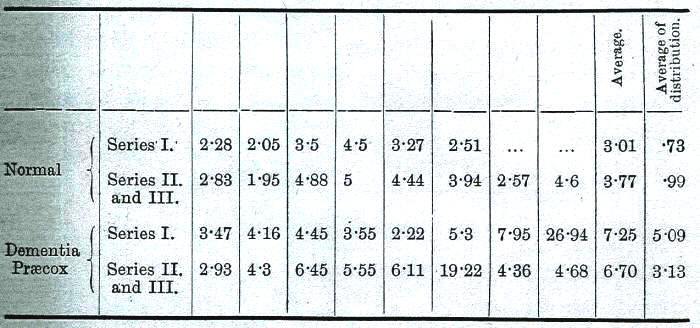
The average of distribution is obtained by subtracting the ordinary average from the larger numbers in the series, or the smaller numbers from the average. The sum of these differences is divided by the number of items, which gives what is called the average of distribution or the average of differences―a useful method of showing wide fluctuations in pathological conditions.
CHAPTER V―ASSOCIATION EXPERIMENTS Galton, Wundt, Kraepelin, Aschaffenburg, Sommer and others, have introduced into psychology a very simple experiment, consisting of the calling out of a word to the test person, who must respond as quickly as possible with the first word that occurs to him. The reaction time between the stimulus word and the response, can be measured with a one-fifth second and stop watch. It was originally expected that this method would reveal certain intellectual differences in various individuals. But from the results of investigations carried out in the Psychiatric Clinic at Zürich, it has been found that it is not intellectual factors, but the emotions that play the chief part in determining these associations. Two persons, of the same social plane, one intelligent, the other unintelligent, even with differences in the character of their intellectual development, may still produce similar associations, because language itself has many general word connections which are familiar to all sorts of individuals belonging to the same circle of society. There are certain well-marked differences between the word associations of educated and uneducated persons. For instance, the uneducated prefer inner connections with deeper meaning, while the educated very often select simply superficial and linguistic associations. This difference depends, as has been ascertained, at the Zürich Clinic, upon the fact that the uneducated fix their attention more closely than the educated upon the actual meaning of the stimulus word. But attention, as has been shown by Bleuler, is nothing more than an emotional process. All affective processes are more or less clearly connected with physical manifestations, which are also to be observed in conjunction with attention. It is therefore to be expected that the attention roused by every association should have an influence upon the galvanometer curve, though this is but one of the affective factors represented in an association experiment. We observe, as a rule, considerable variation in reaction time, even with practised and quick test persons. One is inclined to explain such irregularities, which are apparently accidental, by supposing the stimulus word to be unusual and difficult, or that the attention is momentarily relaxed or some reason or another. Such may at times be the case, but these reasons are not sufficient to explain the frequent repetition and long duration of certain reaction times. There must be some constant and regular rule to account for them. This disturbing factor has been found at the Zürich Clinic to be in most cases some characteristic thought complex of intrinsic importance for the personality of the test person. The following series will illustrate our meaning:―
The four italicised numbers are abnormally long reaction times. The stimulus words are quite ordinary, not difficult, and are such as commonly carry numerous current connections. By questioning the patient, we learn that recently, when greatly depressed, he had determined to commit suicide by drowning. Water, lake, ship, swim, were words that excited this complex. The complex brought about lengthening of the reaction time. This phenomenon is quite usual, and is to be observed constantly and everywhere in association studies. Lengthened reaction time may therefore be regarded as a complex indicator, and be employed for the selection from a series of associations of such as have a personal significance to the individual. It is self-evident that associations of this kind are apt to be accompanied by lively emotional tone. The explanation would be simple if the test person were always conscious of the complex which had been excited. But it is extraordinarily common for the test person to be unconscious of the complex disturbed by the stimulus word, and to be unable to answer questions relating to it. It is then necessary to employ the psycho-analytic method, which Freud uses, for the investigation of dreams and hysteria. It would carry us too far to describe here the details of this method of analysis, and readers must be referred to Freud's works [4]. The cause of the interference with the reaction must be sought for in the strong emotional tone of the complex. Continued...
____________ 1 Veraguth presented his entire results to date for discussion at the second Deutscher Congress für experimentelle Psychologie in Würtzburg in 1906, the transactions of which will be published early this year (1907). 2 On one occasion with three persons in the circuit and one Bunsen cell, the sudden fall of a weight with loud noise caused a deflection of two centimetres. 3 All tracings except figs. 9, 14, 15, 18, have been reduced to one eighth their size. 4 Fig. 9 reproduces the actual size of the tracing. [Approx. same for screen size.] 5 "Acting up to realties."
|
